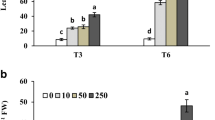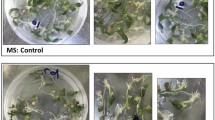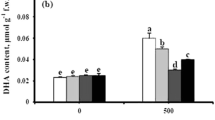Abstract
Due to many uses of zinc oxide nanoparticles (ZnO NPs) in various industries, the release of these particles in the environment and their effects on living organisms is inevitable. In this study, the role of salicylic acid (SA) pretreatments in modulating the toxicity of ZnO NPs was investigated using a hydroponic system. After pretreatment with different concentrations of SA (0, 25, 75, and 150 μM), Chenopodium murale plants were exposed to ZnO NPs (50 mg L−1). The results showed that exogenous SA increased the length, weight, chlorophyll, proline, starch, and soluble sugars in the plants. Besides, SA pretreatments improved water status in the plants treated with ZnO NPs. In SA-pretreated plants, increased activity of catalase (CAT), guaiacol peroxidase (GPX), and superoxide dismutase (SOD) was associated with a decline in electrolyte leakage (EL %) and membrane peroxidation. Under NPs stress, SA pretreatments increased the content of phenolic compounds by increasing the activity of phenylalanine ammonia-lyase (PAL). Exogenous SA reduced the translocation of larger amounts of Zn to the shoots, with more accumulation in the roots. This result can be used to produce healthy food from plants grown in environments contaminated with nanoparticles. It seems that all concentrations of SA reduced the symptoms of ZnO NPs toxicity in the plant by strengthening the function of the antioxidant system and increasing the content of some metabolites. Findings also suggest that SA pretreatment can compensate for the growth reduction caused by ZnO NPs.



Similar content being viewed by others
Data availability
The datasets used and/or analyzed during the current study are available from the corresponding author on reasonable request.
Abbreviations
- ABA:
-
Abscisic acid
- BR:
-
Brassinosteroids
- CAT:
-
Catalase
- Chl:
-
Chlorophyll
- EL:
-
Electrolyte leakage
- DW:
-
Dry weight
- FW:
-
Fresh weight
- GA:
-
Gibberellic acid
- GPX:
-
Guaiacol peroxidase
- H2O2 :
-
Hydrogen peroxide
- MDA:
-
Malondialdehyde
- PAL:
-
Phenylalanine ammonia-lyase
- PSB:
-
Phosphate buffer
- ROS:
-
Reactive oxygen species
- RWC:
-
Relative water content
- TBA:
-
Thiobarbituric acid
- TFC:
-
Total flavonoid content
- TPC:
-
Total phenol content
- TCA:
-
Trichloroacetic acid
- TW:
-
Turgid weight
- SA:
-
Salicylic acid
- SOD:
-
Superoxide dismutase
- TF:
-
Translocation factor
- ZnO NPs:
-
Zinc oxide nanoparticles
References
Abbasi BH, Ullaha MA, Nadeema M, Tungmunnithum D, Hano C (2020) Exogenous application of salicylic acid and gibberellic acid on biomass accumulation, antioxidant and anti-inflammatory secondary metabolites production in multiple shoot culture of Ajuga integrifolia Buch. Ham Ex DDon. Ind Crop Prod 145:112098
Arif Y, Sami F, Siddiqui H, Bajguz A, Hayat S (2020) Salicylic acid in relation to other phytohormones in plant: a study towards physiology and signal transduction under challenging environment. Environ Exp Bot 175:104040
Bahador E, Einali A, Azizian-Shermeh O, Sangtarash MH (2019) Metabolic responses of the green microalgae Dunaliella salina to silver nanoparticles-induced oxidative stress in the presence of salicylic acid treatment. Aquat Toxicol 217:105356
Bandyopadhyay S, Plascencia-Villa G, Mukherjee A, Rico CM, José-Yacamán M, Peralta-Videa JR, Gardea-Torresdey JL (2015) Comparative phytotoxicity of ZnO NPs, bulk ZnO, and ionic Zn onto the alfalfa plants symbiotically associated with Sinorhizobium meliloti in soil. Sci Total Environ 515-516:60–69
Bates S (1973) Rapid determination of free proline for water stress studies. Plant Soil 39:205–207
Bradford MM (1976) A rapid and sensitive method for quantification of microgram quantities of protein utilizing the principle of protein-dye binding. Anal Biochem 72:248–254
Chaoui A, Mazhoudi S, Ghorbal MH, Ferjani EE (1997) Cadmium and zinc induction of lipid peroxidase and effects on antioxidant enzyme activities in bean (Phaseolus vulgaris L.). Plant Sci 127:139–147
Chaturvedi AK, Surendran U, Gopinath G, Chandran KM, Anjali NK (2019) Elucidation of stage specific physiological sensitivity of okra to drought stress through leaf gas exchange, spectral indices, growth and yield parameters. Agric Water Manag 222:92–104
Dai LP, Xiong ZT, Hung Y, Li MJ (2006) Cadmium-induced changes in pigments, total phenolics, and phenylalanine ammonia-lyase activity in fronds of Azolla imbricata. Environ Toxicol 21:505–512
Ding P, Ding Y (2020) Stories of salicylic acid: a plant defense hormone. Trends Plant Sci 25(6):549–565
Dionisio-Sese ML, Tobita S (1998) Antioxidant responses of rice seedlings to salinity stress. Plant Sci 135:1–9
Dubois M, Gilles KA, Hamilton JK, Rebers PA, Smith F (1956) Colorimetric method of determination of sugars and related substances. Anal Chem 28:350–356
Estaji A, Niknam F (2020) Foliar salicylic acid spraying effect’ on growth, seed oil content, and physiology of drought-stressed Silybum marianum L. plant. Agric Water Manag 234:106116
Farooq MA, Niazib AK, Saifullah JA, Farooq M, Souri Z, Karimi N, Rengel Z (2019) Acquiring control: the evolution of ROS-induced oxidative stress and redox signaling pathways in plant stress responses. Plant Physiol Biochem 141:353–369
García-Gómez C, Obrador A, González D, Babín M, Fernández MD (2017) Comparative effect of ZnO NPs, ZnO bulk and ZnSO4 in the antioxidant defenses of two plant species growing in two agricultural soils under greenhouse conditions. Sci Total Environ 589:11–24
García-Sánchez S, Bernales I, Cristobal S (2015) Early response to nanoparticles in the Arabidopsis transcriptome compromises plant defense and root-hair development through salicylic acid signaling. BMC Genomics 16:341–358
Ghassemi-Golezani K, Hassanzadeh N, Shakiba MR, Esmaeilpour B (2020) Exogenous salicylic acid and 24-epi-brassinolide improve antioxidant capacity and secondary metabolites of Brassica nigra. Biocatal Agric Biotechnol 26:101636
Ghosh M, Jana A, Sinha S, Jothiramajayam M, Nag A, Chakraborty A, Mukherjee A, Mukherjee A (2016) Effects of ZnO nanoparticles in plants: cytotoxicity, genotoxicity, deregulation of antioxidant defenses, and cell-cycle arrest. Mutat Res Genet Toxicol Environ Mutagen 807:25–32
Gomes MP, Duarte DM, Carneiro MMLC, Barreto LC, Carvalho M, Soares AM, Guilherme LR, Garcia QS (2013) Zn tolerance modulation in Myracrodruon urundeuva plants. Plant Physiol Biochem 67:1–6
Ha YM, Shang Y, Yang D, Nam KH (2018) Brassinosteroid reduces ABA accumulation leading to the inhibition of ABA-induced stomatal closure. Biochem Biophys Res Commun 504:143–148
Heath RL, Packer L (1968) Photoperoxidation in isolated chloroplasts 1. Kinetics and stoichiometry of fatty acid peroxidation. Arch Biochem Biophys 125:189–198
Iftikhar A, Ali S, Yasmeen T, Arif MS, Zubair M, Rizwan M, Alhaithloul HAS, Alayafi AAM, Soliman MH (2019) Effect of gibberellic acid on growth, photosynthesis and antioxidant defense system of wheat under zinc oxide nanoparticle stress. Environ Pollut 254:113109
Ignatenko A, Talanova V, Repkina N, Titov A (2019) Exogenous salicylic acid treatment induces cold tolerance in wheat through promotion of antioxidant enzyme activity and proline accumulation. Acta Physiol Plant 41(6):80. https://doi.org/10.1007/s11738-019-2872-3
Jing C, Cheng Z, Li-ping L, Zhong-yang S, Xue-bo P (2007) Effects of exogenous salicylic acid on growth and H2O2-metabolizing enzymes in rice seedlings under lead stress. J Environ Sci 19:44–49
Kaya C, Ashraf M, Alyemeni MN, Ahmad P (2020) The role of endogenous nitric oxide in salicylic acid-induced up-regulation of ascorbate-glutathione cycle involved in salinity tolerance of pepper (Capsicum annuum L.) plants. Plant Physiol Biochem 147:10–20
Kotapati KV, Palaka BK, Ampasala DR (2017) Alleviation of nickel toxicity in finger millet (Eleusine coracana L.) germinating seedlings by exogenous application of salicylic acid and nitric oxide. Crop J 5:240–250
Kováčik J, Klejdus B, Hedbavny J, Bačkor M (2010) Effect of copper and salicylic acid on phenolic metabolites and free amino acids in Scenedesmus quadricauda (Chlorophyceae). Plant Sci 178:307–311
Kumaraswamy RV, Kumari S, Choudhary RC, Sharma SS, Pal A, Raliya R, Biswas P, Saharan V (2019) Salicylic acid functionalized chitosan nanoparticle: a sustainable biostimulant for plant. Int J Biol Macromol 123:59–69
Kumari A, Pandey-Rai S (2018) Enhanced arsenic tolerance, and secondary metabolism by modulation of gene expression and proteome profile in Artemisia annua L. after application of exogenous salicylic acid. Plant Physiol Biochem 132:590–602
La VH, Lee BR, Islam MT, Park SH, Jung HI, Bae DW, Kim TH (2019) Characterization of salicylic acid-mediated modulation of the drought stress responses: reactive oxygen species, proline, and redox state in Brassica napus. Environ Exp Bot 157:1–10
Li M, Ahammed GJ, Li C, Bao X, Yu J, Huang C, Yin H, Zhou J (2016) Brassinosteroid ameliorates zinc oxide nanoparticles-induced oxidative stress by improving antioxidant potential and redox homeostasis in tomato seedling. Front Plant Sci 7:615
Lichtenthaler HK (1987) Chlorophylls and carotenoids: pigments of photosynthetic biomembranes. Methods Enzymol 148:350–382
Lotfi R, Ghassemi-Golezani K, Pessarakli M (2020) Salicylic acid regulates photosynthetic electron transfer and stomatal conductance of mung bean (Vigna radiata L.) under salinity stress. Biocatal Agric Biotechnol 26:101635
Lu Q, Zhang T, Zhang W, Su C, Yang Y, Hu D, Xu Q (2018) Alleviation of cadmium toxicity in Lemna minor by exogenous salicylic acid. Ecotoxicol Environ Saf 147:500–508
Manquián-Cerda K, Escudey M, Zúñiga G, Arancibia-Miranda N, Molina M, Cruces E (2016) Effect of cadmium on phenolic compounds, antioxidant enzyme activity, and oxidative stress in blueberry (Vaccinium corymbosum L.) plantlets grown in vitro. Ecotoxicol Environ Saf 133:316–326
Michalak A (2010) Phenolic compounds and their antioxidant activity in plants growing under heavy metal stress. Pol J Environ Stud 15:523–530
Mirzaei H, Darroudi M (2017) Zinc oxide nanoparticles: biological synthesis and biomedical applications. Ceram Int 43(1):907–914
Molnár Á, Papp M, Kovács DZ, Bélteky P, Oláh D, Feigl G, Szőllősi R, Rázga Z, Ördög A, Erdei L, Rónavári A, Kónya Z, Kolbert Z (2020) Nitro-oxidative signaling induced by chemically synthesized zinc oxide nanoparticles (ZnO NPs) in Brassica species. Chemosphere 251:126419
Mosquera-Sánchez PA, Arciniegas-Grijalba MC, Patiño-Portela BE, Guerra-Arias JE, Muñoz-Florez JE, Rodríguez-Páez (2020) Antifungal effect of zinc oxide nanoparticles (ZnO-NPs) on Colletotrichum sp., causal agent of anthracnose in coffee crops L.P. Biocatal Agric Biotechnol 25:101579
Ochoa-Alejo N, Gòmez-Peralta JE (1993) Activity of enzymes involved in capsaicin biosynthesis in callus tissue and fruits of chili pepper (Capsicum annuum L.). J Plant Physiol 141:147–152
Osama S, Sherei ME, Al-Mahdy DA, Bishr M, Salama O (2019) Effect of salicylic acid foliar spraying on growth parameters, γ-pyrones, phenolic content and radical scavenging activity of drought stressed Ammi visnaga L. plant. Ind Crop Prod 134:1–10
Pieczynski M, Marczewski W, Hennig J, Dolata J, Bielewicz D, Piontek P, Wyrzykowska A, Krusiewicz D, Strzelczyk-Zyta D, Konopka-Postupolska D, Krzeslowska M, Jarmolowski A, Szweykowska-Kulinska Z (2013) Down-regulation of CBP80 gene expression as a strategy to engineer a drought-tolerant potato. Plant Biotechnol J 11(4):459–469
Poor P, Gémes K, Horváth F, Szepesi A, Simon ML, Tari I (2011) Salicylic acid treatment via the rooting medium interferes with stomatal response, CO2 fixation rate and carbohydrate metabolism in tomato, and decreases harmful effects of subsequent salt stress. Plant Biol 13(1):105–114
Reddy Pullagurala VL, Adisa IO, Rawat S, Kim B, Barrios AC, Medina-Velo IA, Hernandez-Viezcas JA, Peralta-Videa JR, Gardea-Torresdey JL (2018) Finding the conditions for the beneficial use of ZnO nanoparticles towards plants - a review. Environ Pollut 241:1175–1181
Sabir S, Arshad M, Chaudhari SK (2014) Zinc oxide nanoparticles for revolutionizing agriculture: synthesis and applications. Sci World J 2014:925494. https://doi.org/10.1155/2014/925494
Saidi I, Ayouni M, Dhieb A, Chtourou Y, Chaïbi W, Djebali W (2013) Oxidative damages induced by short-term exposure to cadmium in bean plants: protective role of salicylic acid. S Afr J Bot 85:32–38
Sarropoulou V, Dimassi-Theriou K, Therios I, Koukourikou-Petridou M (2012) Melatonin enhances root regeneration, photosynthetic pigments, biomass, total carbohydrates and proline content in the cherry rootstock PHL-C (Prunus avium _ Prunus cerasus). Plant Physiol Biochem 61:162–168
Schlegel HG (1956) Die Verwertung organischer Säuren durch Chlorella im Licht. Planta 47:510–526
Shi Q, Zhu Z (2008) Effects of exogenous salicylic acid on manganese toxicity, element contents, and antioxidative system in cucumber. Environ Exp Bot 63:317–326
Singh AP, Dixit G, Mishra S, Dwivedi S, Tiwari M, Mallick S, Pandey V, Trivedi PK, Chakrabarty D, Tripathi RD (2015) Salicylic acid modulates arsenic toxicity by reducing its root to shoot translocation in rice (Oryza sativa L.). Front Plant Sci 6:340
Singh AP, Dixit G, Kumar A, Mishra S, Kumar N, Dixit S, Singh PK, Dwivedi S, Trivedi PK, Pandey V, Dhankher OP, Norton GJ, Chakrabarty D, Tripathi RD (2017) A protective role for nitric oxide and salicylic acid for arsenite phytotoxicity in rice (Oryza sativa L.). Plant Physiol Biochem 115:163–173
Singleton VL, Rossi JR (1965) Colorimetry of total phenolics with phosphomolybdic-phosphotungestic acid reagent. Am J Enol Vitic 16:144–158
Szalai G, Krantev A, Yordanova R, Popova LP, Janda T (2013) Influence of salicylic acid on phytochelatins synthesis in Zea mays during Cd stress. Turk J Bot 37:708–714
Tajic S, Zarinkamar F, Mohammad Soltani B, Nazari M (2019) Induction of phenolic and flavonoid compounds in leaves of saffron (Crocus sativus L.) by salicylic acid. Sci Hortic 257:108751
Vankova R, Landa P, Podlipná R, Dobrev P, Přerostová S, Langhansová L, Gaudinova A, Moťková K, Knirsch V, Vanek T (2017) ZnO nanoparticle effects on hormonal pools in Arabidopsis thaliana. Sci Total Environ 593-594:535–542
Velikova V, Yordanov I, Edreva A (2000) Oxidative stress and some antioxidant systems in acid rain-treated bean plants: protective role of exogenous poly-amines. Plant Sci 151:59–66
Viswanath KK, Palaka BK, Ampasala DR (2017) Alleviation of nickel toxicity in finger millet (Eleusine coracana L.) germinating seedlings by exogenous application of salicylic acid and nitric oxide. Crop J 5:240–250
Wang C, Zhang SH, Wang PF, Qian J, Hou J, Zhang WJ, Lu J (2009) Excess Zn alters the nutrient uptake and induces the antioxidative responses in submerged plant Hydrilla verticillata (L.f.) Royle. Chemosphere 76(7):938–945
Wang LJ, Fan L, Loescher W, Duan W, Liu GJ, Cheng JS, Luo HB, Li SH (2010) Salicylic acid alleviates decreases in photosynthesis under heat stress and accelerates recovery in grapevine leaves. BMC Plant Biol 10:34. https://doi.org/10.1186/1471-2229-10-34
Zengin F (2014) Exogenous treatment with salicylic acid alleviating copper toxicity in bean seedlings. Proc Natl Acad Sci India Sect B Biol Sci 84(3):749–755. https://doi.org/10.1007/s40011-013-0285-4
Zhishen J, Mengcheng T, Jianming W (1999) The determination of flavonoid contents in mulberry and their scavenging effects on superoxide radicals. Food Chem 64:555–559
Zhou ZS, Guo K, Elbaz AA, Yang ZM (2009) Salicylic acid alleviates mercury toxicity by preventing oxidative stress in roots of Medicago sativa. Environ Exp Bot 65:27–34
Zoufan P, Karimiafshar A, Shokati S, Hassibi P, Rastegarzadeh S (2018) Oxidative damage and antioxidant response in Chenopodium murale L. exposed to elevated levels of Zn. Braz Arch Biol Technol 61:1–15
Zoufan P, Azad Z, Rahnama Ghahfarokhie A, Kolahi M (2020a) Modification of oxidative stress through changes in some indicators related to phenolic metabolism in Malva parviflora L. exposed to cadmium. Ecotoxicol Environ Saf 187:109811
Zoufan P, Baroonian M, Zargar B (2020b) ZnO nanoparticles-induced oxidative stress in Chenopodium murale L, Zn uptake, and accumulation under hydroponic culture. Environ Sci Pollut Res 27(10):11066–11078
Funding
This work was supported by the Research Affairs of Shahid Chamran University of Ahvaz (grant no. SCU.SB98.746).
Author information
Authors and Affiliations
Contributions
ST performed all the assessments related to growth and biochemical parameters; PZ designed and conducted the research, analyzed the data, and wrote the paper; BZ helped as consultant to carry out some chemical protocols. All authors revised the manuscript and approved submission of this work.
Corresponding author
Ethics declarations
Ethics approval and consent to participate
Not applicable.
Consent for publication
Not applicable.
Competing interests
The authors declare no competing interests.
Additional information
Responsible Editor: Gangrong Shi
Publisher’s note
Springer Nature remains neutral with regard to jurisdictional claims in published maps and institutional affiliations.
Rights and permissions
About this article
Cite this article
Taherbahrani, ., Zoufan, P. & Zargar, B. Modulation of the toxic effects of zinc oxide nanoparticles by exogenous salicylic acid pretreatment in Chenopodium murale L.. Environ Sci Pollut Res 28, 65644–65654 (2021). https://doi.org/10.1007/s11356-021-15566-y
Received:
Accepted:
Published:
Issue Date:
DOI: https://doi.org/10.1007/s11356-021-15566-y




